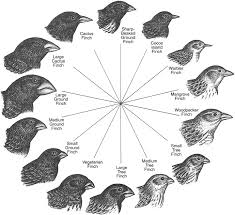Darwin’s Finches : Recent Study

In research published recently, biologists have identified a key connection between ecology and speciation in Darwin’s finches, famous residents of the Galapagos Islands.
- Darwin’s finches, named after Charles Darwin, are small land birds.
- They comprise a group of 15 species endemic to the Galápagos (14 species) and Cocos (1 species) Islands in the Pacific Ocean.
- The group is monophyletic and originated from a common ancestral species that reached the Galápagos Archipelago from Central or South America.
- Descendants of this ancestor on the Archipelago then colonized Cocos Island.
- Darwin’s finches are all very similar in shape, size, and colour, but there are a few differences which can help when identifying them.
- These include diet, habitat, and beak size and shape.
- They’re known for their remarkably diverse beak form and function, evolved to suit the different food types available across the islands.
- From seeds and fruits to invertebrates and even blood, their widely varied beak shapes and sizes have allowed each species to occupy different niches of the islands.
- Darwin’s finches are the classic example of adaptive radiation, the evolution of groups of plants or animals into different species adapted to specific ecological niches.




